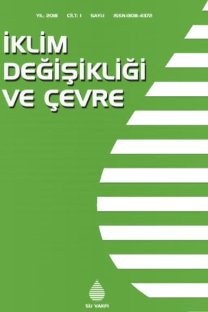Evsel Atıksuların Solar TiO2 Fotokatalizi ile Dezenfeksiyonu
Atıksu dezenfeksiyonunun temel amacı, deşarjlar sonucu, yüzeysel sulara patojenlerin ulaşmasının önlenmesi ve böylece, halk sağlığının korunmasıdır. Atıksu dezenfeksiyonunda kullanılan klasik yöntemlerin, yan ürün oluşumu, yüksek enerji gereksinimi ve yüksek maliyet gibi dezavantajları bulunduğundan, son çalışmalar, güneş ışığına dayalı ileri oksidasyon prosesleri üzerine yoğunlaşmıştır. Hidroksil radikallerinin oluşumuna dayanan bu prosesler, sulardaki pek çok kirleticinin ve mikroorganizmanın gideriminde kullanılmaktadır. Ayrıca, güneş ışığı kullanıldığı için, bu prosesler, çevreye dost olarak nitelendirilebilir. Bu çalışmada, ileri oksidasyon proseslerinden olan solar TiO2 fotokatalizi ile evsel atıksuların dezenfeksiyonu incelenmiştir. Sentetik evsel atıksuların dezenfeksiyonu, solar ışık altında, farklı TiO2 konsantrasyonlarında (0-0,3-0,5-1-5-10 mg/L) incelenmiştir. Solar TiO2 fotokatalizinin evsel atıksulardan E.coli ve E.faecalis gideriminde etkili olduğu belirlenmiştir. E.coli için elde edilen giderim verimleri, E.faecalis’e göre daha yüksektir. Bu fark, en belirgin şekilde, 0,5 mg/L TiO2 konsantrasyonu için gözlenmiş olup, 60 dk.’da E.coli için elde edilen giderim, 5,45-log iken, E.faecalis için elde edilen giderim 3,80-log olarak bulunmuştur.
Anahtar Kelimeler:
Dezenfeksiyon, Evsel atıksu, Solar, TiO2 fotokatalizi
___
- Alrousan, D.M.A., M.I. Polo-Lopez, P.S.M. Dunlop, P. Fernandez-Ibanez, and J.A. Byrne (2012), Solar photocatalytic disinfection of water with immobilised titanium dioxide in re-circulating flow CPC reactors, Appl. Catal., B, 128, 126-134, doi:10.1016/j.apcatb.2012.07.038.
- Backhaus, K., J. Marugan, R.V. Grieken and C. Sordo (2010), Photocatalytic inactivation of E.faecalis in secondary wastewater plant effluents, Water Sci Technol, 61(9), 2355-2361, doi: 10.2166/wst.2010.056.
- Benabbou, A.K., Z. Derriche, C. Felix, P. Lejeune and C. Guillard (2007), Photocatalytic inactivation of Escherischia coli: effect of concentration of TiO2 and microorganism, nature, and intensity of UV irradiation, Appl. Catal., B, 76, 257–263, doi: 10.1016/j.apcatb.2007.05.026.
- Clescerl, L.S., A.E. Greenberg and A.D. Eaton (1998), Standard methods for the examination of water and wastewater, 20.Baskı, APHA, AWWA & WEF, Washington.
- Dejung,S., I. Fuentes, G. Almanza, R. Jarro,R, L. Navarro, G. Arias, E. Urquieta, A. Torrico, W. Fenandez, M. Iriarte, C. Birrer, W.A. Stahel and M. Wegelin (2007), Effect of solar water disinfection (SODIS) on model microorganisms under improved and field SODIS conditions, J. Water Supply Res. Technol. AQUA, 56(4), 245-256, doi: 10.2166/aqua.2007.058.
- Foster, H.A., I.B. Ditta, S. Varghese and A. Steele (2011), Photocatalytic disinfection using titanium dioxide:spectrum and mechanism of antimicrobial activity, Appl. Microbiol. Biotechnol., 90(6), 1847–1868, doi: 10.1007/s00253-011-3213-7.
- Gamage, J. and Z. Zhang, Z. (2010), Applications of photocatalytic disinfection, Int. J. Photoenergy, 2010, Article ID 764870, 11 pages, doi: 10.1155/2010/764870.
- Giannakis, S., E. Darakas, A. Escalas-Cañellas and C. Pulgarin (2015), Environmental considerations on solar disinfection of wastewater and the subsequent bacterial (re)growth, Photochem. Photobiol. Sci., 14, 618–625, doi: 10.1039/c4pp00266k.
- Hassen, A., M. Mahrouk, H. Ouzari, M. Cherif, A. Boudabous and J.J. Damelincourt (2000), UV disinfection of treated wastewater in a large-scale pilot plant and inactivation of selected bacteria in a laboratory UV device, Bioresour. Technol., 74, 141-151, doi: 10.1016/S0960-8524(99)00179-0.
- Herrera Melián, J.A., J.M. Doña Rodrı́guez, A. Viera Suárez, E. Tello Rendón, C. Valdés do Campo, J. Arana and J. Pérez Peña (2000), The photocatalytic disinfection of urban wastewaters, Chemosphere, 41(3), 23-327, doi: 10.1016/S0045-6535(99)00502-0.
- Lydakis-Simantiris, N., D. Riga, E. Katsivela, D. Mantzavinos and N.P. Xekoukoulotakis (2010), Disinfection of spring water and secondary treated municipal wastewater by TiO2 photocatalysis, Desalination, 250, 351–355, doi: 10.1016/j.desal.2009.09.055.
- Madigan, M.T., J.M. Martinko and J. Parker (2003), Brock biology of microorganisms, 10.Baskı, Prentice-Hall, Upper Saddle River.
- Malato, S., P. Fernandez-Ibanez, M.I. Maldonado, J. Blanco and W. Gernjak (2009), Decontamination and disinfection of water by solar photocatalysis: recent overview and trends, Catal. Today, 147, 1–59, doi: 10.1016/j.cattod.2009.06.018.
- Maness, P.C., S. Smolinski, D.M. Blake, Z. Huang, E.J. Wolfrum and W.A. Jacoby (1999), Bactericidal activity of photocatalytic TiO2 reaction:toward an understanding of its killing mechanism, Appl. Environ. Microbiol., 65(9), 4094–4098.
- Marugán, J., R. van Grieken, C. Sordo and C. Cruz (2008), Kinetics of the photocatalytic disinfection of Escherichia coli suspensions, Appl. Catal., B, 82, 27-36, doi:10.1016/j.apcatb.2008.01.002.
- Matsunaga, T., R. Tomoda, T. Nakajima and H. Wake (1985), Photoelectrochemical sterilization of microbial cells by semiconductor powders, FEMS Microbiol Lett, 29, 211-214.
- Ortega-Gómez, E., B.E. García, M.M.B. Martín, P. Fernández-Ibáñez and J.A.S. Pérez (2013), Inactivation of Enterococcus faecalis in simulated wastewater treatment plant effluent by solar photo-fenton at initial neutral pH, Catal. Today, 209, 195-200, doi:10.1016/j.cattod.2013.03.001.
- Rincon, A.G. and C. Pulgarin (2003), Photocatalytical inactivation of E.coli:effect of (continuous-intermittent) light intensity and of (suspended-fixed) TiO2 concentration, Appl. Catal., B, 44, 263-284, doi: 10.1016/S0926-3373(03)00076-6.
- Rincon, A.G. and C. Pulgarin (2004), Effect of pH, inorganic ions, organic matter and H2O2 on E.coli K12 photocatalytic inactivation by TiO2. Implications in solar water disinfection, Appl. Catal., B, 51, 283-302, doi: 10.1016/j.apcatb.2004.03.007.
- Rodríguez-Chueca, J., M.I. Polo-López, R. Mosteo, M.P. Ormad and P. Fernández-Ibáñez (2014), Disinfection of real and simulated urban wastewater effluents using a mild solar photo-fenton, Appl. Catal., B, 150-151, 619-629, doi: 10.1016/j.apcatb.2013.12.027.
- Singer, C.P. (1999), Formation and control of disinfection by-products in drinking water, AWWA, USA.
- Tchobanoglous, G., F.L. Burton and H.D. Stensel (2004), Wastewater engineering:treatment and reuse, 4.Baskı, Mc Graw-Hill, Singapore.
- Teksoy, A., U. Alkan, S.Ç. Eleren, B.Ş. Topaç, F.O.T. Şağban and H.S. Başkaya (2011), Comparison of indicator bacteria inactivation by the ultraviolet and the ultraviolet/hydrogen peroxide disinfection processes in humic waters, J. Water Health, 9(4), 659-669, doi:10.2166/wh.2011.205.
- URL1, OECD, France (2001), Guidelines for Testing of Chemicals, Simulation Test-Aerobic Sewage Treatment, 303A, http://www.oecd-ilibrary.org/docserver/download/9730301e.pdf?expires=1519250178&id=id&accname=guest&checksum=75071 F71486868F4154E27D56295782.
- ISSN: 1308-4372
- Başlangıç: 2008
- Yayıncı: Su Vakfı
Sayıdaki Diğer Makaleler
Akuaponik (Biyolojik Arıtma Tekniği) Tekniği ile Balık Atıksularının Arıtılması
Seyhan Havzası Yağış Verilerinin Eğilim Analizi
Şimal Yüce, Burcu Ercan, Musa EŞİT, Mehmet ÜNSAL, Mehmet İshak YÜCE
Nilüfer Çayı Sedimentinde Polisiklik Aromatik Hidrokarbon (PAH) Seviyelerinin İncelenmesi
Güray SALİHOĞLU, Zeynep ÇAKIR, Nezih Kamil SALİHOĞLU
Evsel Atıksuların Solar TiO2 Fotokatalizi ile Dezenfeksiyonu
PAH'lar Ve PCB'lerin Atmosferik Konsantrasyonları: Bursa Doğu Atıksu Arıtma Tesisi Örneği
